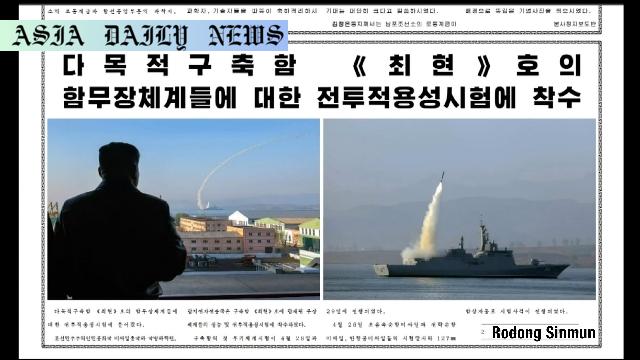Destroyer debuts: North Korea tests cruise missiles and ship-to-ship tactical guided weapons in a show of maritime strength.
- North Korea debuted the Choe Hyon, a 5,000-ton-class destroyer.
- Kim Jong Un observed tests of advanced missiles, including supersonic and strategic cruise types.
- The destroyer features advanced combat capabilities and vertical missile launch systems.
- This unveils North Korea’s plans to accelerate naval nuclear armament.

The Debut of Choe Hyon
In a bold display of military innovation and capability, North Korea has officially introduced its newest destroyer, the Choe Hyon. Touted as a 5,000-ton-class multipurpose vessel, the Choe Hyon represents a significant step forward for Pyongyang’s maritime power. The vessel is reportedly equipped with state-of-the-art combat systems, including a substantial capacity for vertical missile launches—an estimated 74 cells, according to military experts.
The unveiling of the Choe Hyon is more than just a demonstration of military prowess; it showcases North Korea’s strategic ambition to bolster its naval power. North Korean media highlighted that the vessel is capable of carrying ballistic missiles, emphasizing its strategic and tactical importance. This development is a direct response to the increasing naval presence of allied nations in the region, as well as ongoing geopolitical tensions.
Kim Jong Un’s Vision for Naval Armament
Kim Jong Un, North Korea’s Supreme Leader, was in attendance during the ship’s combat readiness tests, underlining the vessel’s critical role in the country’s defense strategy. According to reports, Kim stressed the importance of accelerating the nuclear armament of North Korea’s navy. This pledge is part of an overarching strategy to safeguard the nation’s territorial waters and maritime sovereignty.
The tests included the successful launch of supersonic cruise missiles and more advanced strategic cruise missiles. Additionally, ship-to-ship tactical guided weapons were tested, demonstrating the versatile capabilities of the Choe Hyon. These combat readiness exercises reflect North Korea’s ongoing effort to modernize its military forces and address new challenges in maritime security.
A Maritime Security Shift
The launch of the Choe Hyon emerges during a period of heightened tension in the Asia-Pacific region. As neighboring South Korea and its allies continue their naval exercises, the North is responding with advancements like the Choe Hyon to assert its presence and strategic deterrence. This display underscores North Korea’s commitment to protecting its sovereignty amid escalating military activities in its periphery.
Although South Korean and global experts view this development with concern, it also serves as an indicator of North Korea’s commitment to exploring multi-lateral ways to engage in regional power dynamics. Insights suggest that the Choe Hyon’s strategies include strengthening its long-range strike capacity and maritime capabilities to counteract any perceived threats.
The Global Implications
While North Korea’s naval aspirations may be seen as an internal matter, the broader implications ripple across international waters. As North Korea continues to seek recognition as a nuclear-armed state, military advancements like the Choe Hyon serve as evidence of its challenging trajectory. Nations across the globe, particularly in the Asia-Pacific and neighboring waters, will have to consider strategic responses that balance deterrence and diplomacy.
Despite this, the Choe Hyon’s debut also provides an opportunity for analysts to re-evaluate North Korea’s maritime strategies and to consider what directions their military capacity could take next. The push for naval nuclear armament showcases the potential risks and uncertainties associated with these developments, but also highlights the broader geopolitical game in the region.



Commentary
Introduction to a Strategic Game Changer
North Korea’s unveiling of the Choe Hyon destroyer marks a fascinating yet alarming milestone in modern maritime advancements. This state-of-the-art warship, with its advanced weaponry, appears to embody a significant shift in the nation’s approach to coastal defense and strategic deterrence. Nevertheless, it sends a clear message not only to neighboring South Korea but also to the wider global community.
Kim Jong Un’s Calculated Vision
Kim Jong Un’s strong emphasis on developing naval nuclear capabilities demonstrates a calculated vision of power. It’s clear that North Korea seeks to address perceived vulnerabilities by focusing on an arena of defense that has historically been underexplored: the navy. The decision to fortify maritime defenses and demonstrate robust readiness is undoubtedly in line with its efforts to counterbalance regional threats.
This is a pivot worth appreciating from a strategic lens—it integrates multi-dimensional deterrent measures while signaling sophistication in naval technological advancements. But it also offers a puzzling juxtaposition between showcasing military might and reckoning with humanitarian priorities, both of which consistently affect its image on the international stage.
Challenges and Potential Fallout
On the other side of this coin lies the potential consequences this military move may bring. Diplomacy in the fragile waters of the Korean Peninsula has always been fraught with subtext, ambiguity, and precariousness. The emergence of Choe Hyon threatens to shake the delicate balance of naval presence in these waters, drawing immediate responses from allies like South Korea, Japan, and the United States.
The ship’s considerable capacity for missile launches introduces a new element of complexity to any future negotiations or regional tranquility. However, it also illuminates the urgency of renewed diplomatic efforts centered around disarmament or at least reducing escalation risks.
Conclusion: A Powerful Statement, But What Next?
In summary, while the Choe Hyon is undoubtedly a technical marvel and a bold declaration of military intent, its long-term impact on regional stability remains to be seen. As the global community continues to monitor these developments, it is imperative that constructive diplomatic channels remain open to understanding and addressing the broader implications.